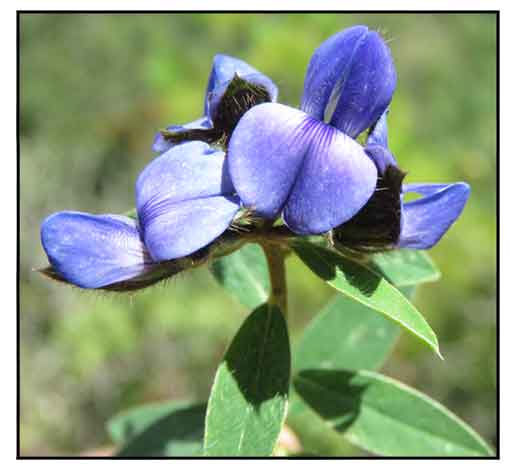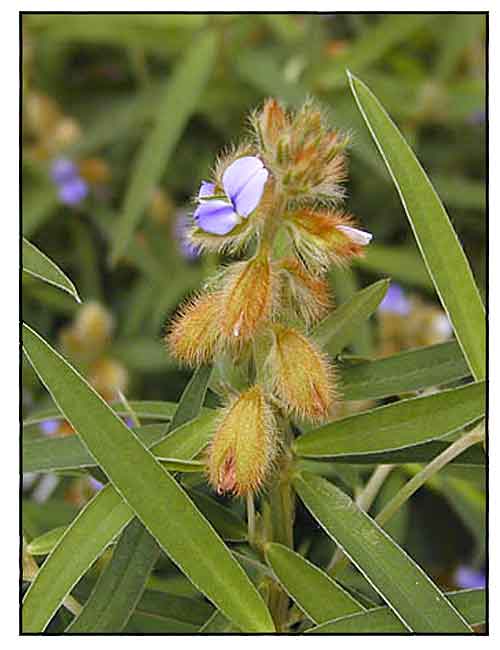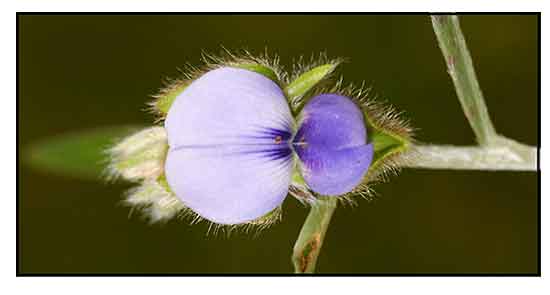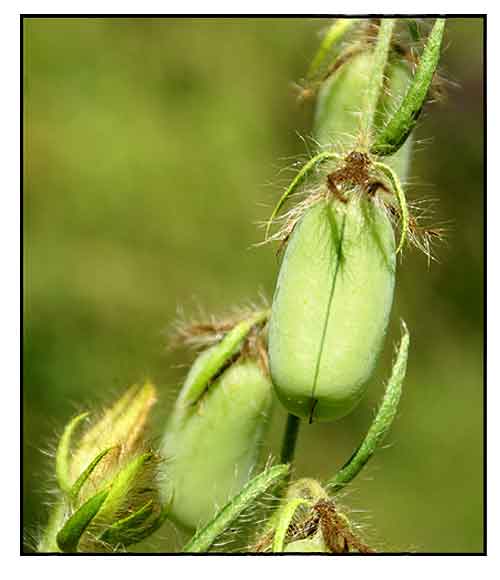 Gen info Gen info
- Crotalaria is a genus of herbaceous plants and wood shrubs in the family Fabaceae, commonly known as rattlepods. The genus includes about 500 species, a majority of about 400 are found in Africa.
- Etymology: The genus name Crotalaria derives from Ancient Greek krotalon, meaning "rattle", the same root as the name for rattlesnakes, crotalus. The specific epithet sessiliflora derives from sessilis, meanng stalkless, and flos, meaning flower. The common names rattlepod or rattlebox refers to the seeds in the pod, becoming loose as they mature, which rattle when shaken.
Botany
• Stalkless Blue Rattlepod is an annual herb, 1-2 ft tall. Branches are velvety with silky hairs. Leaves are simple, about 4.6-15 cm long, linear to lance-shaped, pointed, hairless above, thinly silky below. Stipules are minute. Flowers are borne in a raceme, up to 25 cm long, 2-20-flowered, rarely flowers solitary. Bract and bracteoles are long, setaceous. Sepal cup is 1-1.3 cm long, velvety, hairs brown, silky, teeth pointed. Flowers are blue to purplish blue, slightly shorter than calyx; standard oblong, 7-10 x 4-7 mm, sparsely bristly below along midvein, base with 2 appendages, tip blunt to flat. Wings are oblong to linear-oblong, shorter than standard; keel as long as standard, bent sharply below middle, upper margin proximally woolly, apex extended into straight twisted beak. Fruit is 1.5 cm long, glabrous, sessile, 10-15-seeded. Stalkless Blue Rattlepod is found in Pakistan, India, Himalayas, Burma, China, Japan, Philippines, at altitudes of 100-1600 m. Flowering: May-November. (Flowers of India)
 • Herbs, annual or short-lived perennial, erect, 30-100 cm tall. Stems often branching from lower parts, terete, densely coarsely hirsute. Stipules linear, 2-3 mm, persistent or caduÂcous. Leaves simple; petiole nearly absent; leaf blade variable in shape, usually linear to linear-lanceolate, 3-8 × 0.5-1 cm, abaxially densely silky pubescent, adaxially glabrous, base attenuate, apex acuminate. Racemes terminal or leaf-opposed or densely congested and head-like on branch apices, few to many flowered or flowers solitary in axils; bracts linear-lanceolate, 4-6 mm. Pedicel ca. 2 mm; bracteoles inserted at base of calyx tube, similar to bracts. Calyx 2-lipped, 1-1.5 cm, conspicuously long brownish pilose; abaxial lobes lanceolate to triangular-lanceolate, to 2.5 mm wide, connate for ca. 1/4 of length; adaxÂial lobes ca. 4 mm wide, joined for ca. 1/3 length, apices long acuminate. Corolla blue to purplish blue or pale yellow, slightly shorter than calyx; standard oblong, 7-10 × 4-7 mm, abaxially sparsely strigose along midvein, base with 2 appendages, apex obtuse to retuse; wings oblong to linear-oblong, shorter than standard; keel ± as long as standard, bent sharply below middle, adaxial margin proximally woolly, apex extended into straight twisted beak. Ovary subsessile. Legume dark with age, cylinÂdric, ca. 1 cm, ± included in calyx, 10-15-seeded, glabrous. (Flora of China) • Herbs, annual or short-lived perennial, erect, 30-100 cm tall. Stems often branching from lower parts, terete, densely coarsely hirsute. Stipules linear, 2-3 mm, persistent or caduÂcous. Leaves simple; petiole nearly absent; leaf blade variable in shape, usually linear to linear-lanceolate, 3-8 × 0.5-1 cm, abaxially densely silky pubescent, adaxially glabrous, base attenuate, apex acuminate. Racemes terminal or leaf-opposed or densely congested and head-like on branch apices, few to many flowered or flowers solitary in axils; bracts linear-lanceolate, 4-6 mm. Pedicel ca. 2 mm; bracteoles inserted at base of calyx tube, similar to bracts. Calyx 2-lipped, 1-1.5 cm, conspicuously long brownish pilose; abaxial lobes lanceolate to triangular-lanceolate, to 2.5 mm wide, connate for ca. 1/4 of length; adaxÂial lobes ca. 4 mm wide, joined for ca. 1/3 length, apices long acuminate. Corolla blue to purplish blue or pale yellow, slightly shorter than calyx; standard oblong, 7-10 × 4-7 mm, abaxially sparsely strigose along midvein, base with 2 appendages, apex obtuse to retuse; wings oblong to linear-oblong, shorter than standard; keel ± as long as standard, bent sharply below middle, adaxial margin proximally woolly, apex extended into straight twisted beak. Ovary subsessile. Legume dark with age, cylinÂdric, ca. 1 cm, ± included in calyx, 10-15-seeded, glabrous. (Flora of China)
Distribution
- Native to the
Philippines.
- Also native to Assam, Bangladesh, Cambodia, China North-Central, China South-Central, China Southeast, East Himalaya, Hainan, India, Japan, Jawa, Korea, Laos, Lesser Sunda Is., Malaya, Maluku, Manchuria, Myanmar, Nansei-shoto, Nepal, New Guinea, Northern Territory, Pakistan, Queensland, Sulawesi, Sumatera, Taiwan, Thailand, Tibet, Vietnam, West Himalaya. (1)
 Constituents Constituents
- Phytochemical study of whole plant isolated four flavonoids, identified as: 2',4',5,7-tetrahydroxy-isoflavone (1), 2',4',7-trihydroxyisoflavone (2), 4',7-dihydroxyflavone (3), and isovitexin (4). (4)
- Activity-guided fractionation of EtOAc extract of aerial parts with DPPH isolated 7 antioxidative compounds. (see study below) (5)
- Study of whole plant isolated 12 compounds, identified as: sessiliflorin B (1), quercetin (2), kaempferol (3), soyasapogenol B (4), fernenol (5), neoechinulin A (6), ethyl 4-hydroxybenzoate (7), ethyl caffeate (8), 5,7-dihydroxychromone (9), crotadihydrofuran A (10), butesuperin B (11) and aurantiamide acetate (12).
(8)
- Study of dried and pulverized seeds yielded three pyrrolizidine alkaloids: monocrotaline (1),
integerrimine (2), and trichodesmie (3). (9)
 Properties Properties
- Studies have suggested estrogenic and acetylcholinesterase enhancing, antioxidative, vasodilatory, hypotensive, PA-related hepatotoxic, antitumor properties.
Parts used
Aerial parts.
Uses
Edibility
- Pods and seeds are edible; cooked.
Folkloric
- No reported folkloric medicinal use in the Philippines.
- Paste of plant applied as poultice for headaches.
- Plant used as detoxifier of toxins like DDT, arsenic, poisonous mushrooms, etc.
- Used in Chinese folk medicine as antitumor agent.
Studies
• Antioxidative / Aerial Parts: Activity-guided fractionation of EtOAc extract of aerial parts with DPPH isolated 7 antioxidative compounds. Among isolated compounds, hydroxyeucomic acid showed strongest free radical-scavenging activity against DPPH, almost identical to epigallocatechin gallate. Orientin and isoorientin showed strong anti-peroxidative activity toward linoleic acid and protective effect against bactericidal action of the tert-butyl peroxyl radical, with activities nearly equal to epigallocatechin. (5)
• Estrogenic and Acetylcholinesterase Enhancement Activity: Study of aerial parts isolated a new isoflavone, 7,2',4'-trihydroxyisoflavone-4'-O-beta-D-glucopyranoside. The isolfavone glucoside induced estrogenic activity in a cell proliferation assay using human breast cancer line MCF-7, and proliferation was blocked by ER antagonist tamoxifen, indicating involvement of the ER. The new isoflavone also enhanced the AChE activity of the rat neuronal cell line PC12 at low concentrations of NGF, suggesting involvement of EF. (6)
• Vasodilatory / Hypotensive: Study evaluated the vasoactive effect of C. sessiliflora extract (CSE) on rats. CSE (0.5-5 mg/ml) induced concentration-dependent relaxation on endothelium-intact thoracic aortic rings precontracted with phenylephrine. Endothelium-dependent relaxation caused by CSE was associated with production of cGMP. CSE produced dose-dependent and transient decrease in blood pressure in normotensive rats and the effect was blocked by atropine and L-NNA. Results suggest CSE induced endothelium-dependent relaxation via NO/cGMP signaling by promoting extracellular Ca2+ influx and release of Ca2+ from intracellular stores of endothelium, probably due to endothelial muscaric receptor activation. (3)
• Hepatotoxicity of Pyrrolizidine Alkaloids (PAs) / Adducts as Biomarker: Pyrrolizidine alkaloids (PAs) with 1,2-unsaturated necine base are hepatotoxic phytotoxins. Study evaluated the correlation between formation of hepatic pyrrole-protein adducts and occurrence of PA-induced liver injury (PA-ILI) and explored the use of such adducts for rapid screening of hepatotoxic potency of natural products that contain PAs. The extracts of Crotalaria sessiliflora contain one PA: monocrotaline. Study showed the PA in the herbal extract induced PA-ILI, with typical symptoms of hemorrhage and coagulative necrosis in a dose-dependent manner. There was good correlation between elevation of serum ALT and the formation of hepatic pyrrole-protein adducts, suggesting the adducts can be used as biomarker to indicate degree of hepatotoxicity. (7)
• Antitumor Activity of Pyrrolizidine Alkaloids: C. sessiliflora was reported to have pyrrolizidine alkaloids with anti-tummor properties such as monocrotaline trans-trans platynecic acid (trans,2S,3R) and retronecine, which showed tumor inhibitory activity against Walker carcinoma 256 in rats (Liang, 1980). (10)
• Microwave Extraction of Flavonoids and Alkaloids: Study reports on a novel method of simultaneous extraction and separation of flavonoids and alkaloids from C. sessiliflora by microwave-assisted cloud-point extraction (MACPE) using Triton X-100-NaCl-HCl system as extractant. Extraction yields of vitexin, isovitexin, and monocrotaline reached up to 601.4, 386.7, and 105.5 µg/g, respectively. The proposed method provided a simple and efficient alternative to extraction and separation of active constituents from herb materials. (11)
Availability
- Wild-crafted.
- Seeds in the cybermarket.
|

![]()







